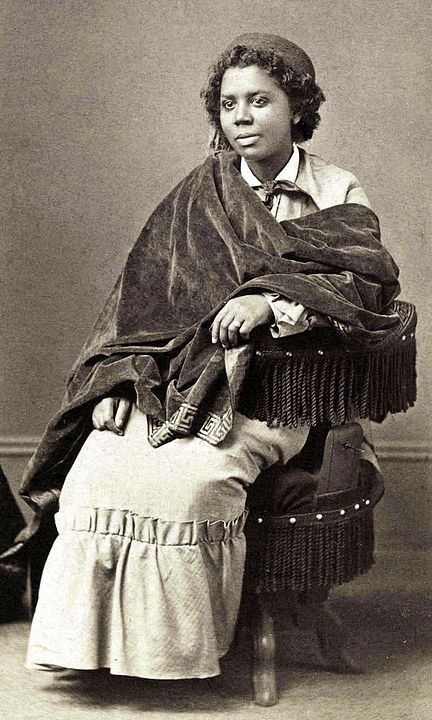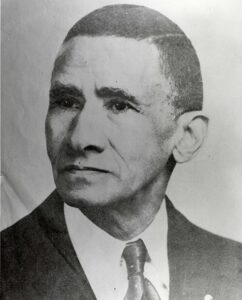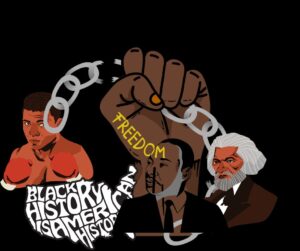Once upon a time in Black Entrepreneur History was an African American woman named Edmonia Mary Lewis who was the first African American female who ever studied sculptural art and become an internationally recognized sculptor.
Edmonia Mary Lewis, born July 4, 1844 in Greenhigh, Ohio[1], was named Wildfire by her Native American mother, who was Chippewa Ojibwe heritage (in the Ohio region of the USA), described by her daughter later in life as being “copper color with straight black hair”. Her father was a free, working African American man. They all lived in the place of her birth along with her older brother named Sunrise.
(Some historical write ups say she was born in Greenbush, NY, but according to her own words in The Leads Mercury paper interview of 1866, she was born in Ohio. This location also is geographically where the Chippewa Native American group was.)
She spent much time taking habits and learning from her mother as a child until her mother passed away, learning how to make moccasins that they would sell to make money. This is potentially where and how Wildfire and her brother Sunrise learned entrepreneurship and how to be self-sufficient[2]. She also spent time fishing and swimming, living a free and wild life, almost care-free, as her mother.
Her older brother Sunrise moved away to California in order to become a gold miner. He sent money back home and became the major financial provider for Wildfire when they no longer had parents as both parents died when she was young. She was raised by her mother’s native American group.
Her brother paid for her to go to school in Albany to which she wasn’t a great student because she wasn’t used to learning from books due to the way she grew up. They put her out, but later, she enrolled in Oberlin College in Ohio. While she was attending Oberlin College, she changed her name from Wildfire to Edmonia Mary Lewis.
Although she planned on graduating from Oberlin College, it never happened because she was falsely accused of poisoning 2 white roommates. Well-known abolitionist William Lloyd Garrison defended her in the highly publicized trial, and she was found innocent, however, her troubles didn’t stop there. After the verdict, she was viciously assaulted by a gang of white people, beaten badly.
It was in 1863 that she took a trip to Boston and saw a statue of Benjamin Franklin, and it was when she came face-to-face with that stone statue (she didn’t know who it was at the time) that Edmonia found a new vision for her future.
She rushed back to the man who defended her, abolitionist William Lloyd Garrison, and told him about her statue discovery in Boston and asked him how she could go about doing that because she was confident she could. It was then that Garrison introduced her to the sculptor Edward Brackett. Brackett took her on and gave her clay and a human foot mould, then told her to recreate it. She failed the first time, but the second time, she’d not only created feet and hands, but also a medallion of the head of abolitionist John Brown.
After that she made her most famous sculpture at that time yet – Colonel Robert Shaw – the first man to lead the colored regiment and was buried with the Black soldiers he led. Not only did the family of Colonel Shaw hear about the piece and that a Black lady was making it, they were impressed and she ended up selling 100 copies of it, earning her enough money to move to Europe, specifically Rome.
In Rome, she found out that she had much more to learn, and while learning, her first sculpture in Rome was called Hagar. Hagar is the handmaid of Sarah in the Bible who was forced to leave Abraham’s home after becoming pregnant with Abraham’s oldest son.
“I have a strong sympathy for all women who have struggled and suffered. For this reason, the Virgin Mary is very dear to me.”
People’s Advocate (Osage Mission, Kansas)· Thu, Jun 22, 1871 · Page 1
Hagar was sold to a man in the United States from the city of Chicago.
Some of Lewis’s other work while in Rome in her own rented studio, formerly used by Italian neoclassical scupltor Antonio Canova[1], include:
- Madonna with infant Christ and two angels at her feet (sold and used as altar piece)
- Hiwatha’s Wooing (based off the poem Hiawatha by Longfellow;Native America memories of making moccasins)
- Wendell Phillips medallion portrait
- Sleeping Babies
- The Freedman at First Hearing of her Liberty
- Death of Cleopatra
- Bride of Spring
Edmonia Lewis chose to work solo, unlike other sculptors in Italy because she wanted full credit for her work. Being that she was African American, she knew full well what could happen, so while many other white sculptors employed others to finish their work, she didn’t. This also benefited her because she could keep all profit. She became known for her solo work, and she even piled her clay into a large mass, which most sculptures didn’t do because it was hard work, and begin sculpting a beautiful piece from it[3].
All that time in Rome, which became her permanent home, she was fully bilingual, Italian being her second language. Her artwork took on the neoclassical form while she tended to create abolitionists, civil war heroes, fantasy, mythology and religious figures while also paying tribute to her African American and Native American history in many of her works.
Lewis returned to the United States a couple of times in her life, traveling by ships, the Ville de Paris on July 1, 1875 and the City of Chester May 2, 1876 in her thirties.
Death
Edmonia Lewis passed away on September 17, 1907 in London City, London, England and buried at St. Mary’s Roman Catholic Cemetery in Kensal Green, London Borough of Brent, Greater London, England. She was 63 years old[4].
Source
[1]The Leeds Mercury (Leeds, West Yorkshire, England) · 10 Mar 1866, Sat · Page 13
[2]The Akron Beacon Journal (Akron, Ohio) · Tue, Jan 24, 1995 · Page 45
[3]People’s Advocate (Osage Mission, Kansas)· Thu, Jun 22, 1871 · Page 1
[4]Ancestry.com. UK and Ireland, Find A Grave Index, 1300s-Current [database on-line]. Provo, UT, USA: Ancestry.com Operations, Inc., 2012.
Ancestry.com. Massachusetts, State Census, 1865 [database on-line]. Provo, UT, USA: Ancestry.com Operations, Inc., 2014.
Year: 1875; Arrival: New York, New York, USA; Microfilm Serial: M237, 1820-1897; Line: 22; List Number: 572
Smithsonian American Art Museum
The News and Observer (Raleigh, North Carolina)· Sun, Oct 15, 2000 · Page 159
Photo Credit: By Henry Rocher – National Portrait Gallery, Smithsonian Institution, Public Domain, https://commons.wikimedia.org/w/index.php?curid=8911218





More Related Stories
Isaac Scott Hathaway – Founder of Isaac Hathaway Art Company & Designer of First African American Coin
James Wormley – Founder of the Most Expensive Hotel in Washington D.C. in 1800s – the Wormley Hotel
William E. Matthews – Wealthy Financial Broker & Civil Rights Leader of 1800s